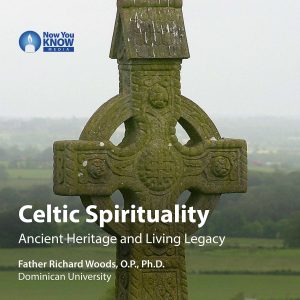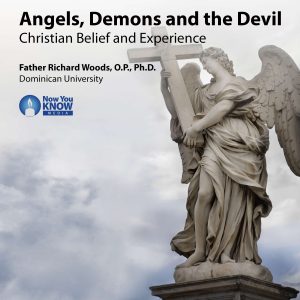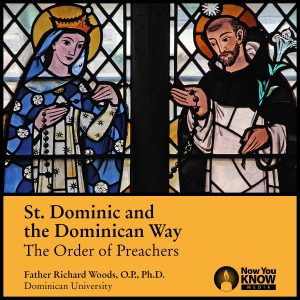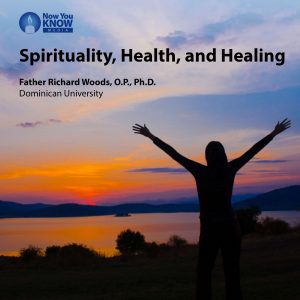Celtic Christianity has produced a kaleidoscopic array of saints, monks and poets.
In this series, Dominican Prof. Richard Woods cultivates more than 1500 years of Celtic spirituality’s rich traditions to acquaint you with the insight that these fascinating figures can offer us today.
Follow along as Fr. Woods delves into the origins, development, and contributions of Christianity as it spread throughout the northwestern region of Europe. After considering what makes a spirituality “Celtic,” you will engage a host of intriguing characters – from the third century to the present – who interpreted the Christian faith in terms of the customs and beliefs of their ancestors.
The monks and saints who recorded the evolution of Celtic Christianity likewise preserved the oldest known north European pagan mythology. The lives of saints such as Patrick, Brigit, Columcille and David of Wales – along with monastic rules – illustrate the vivid history that was celebrated and embellished as much as it was recorded. The saints therefore serve as the chief witnesses to the creation of a unique understanding of a life lived in spiritual, if
Celtic Christianity has produced a kaleidoscopic array of saints, monks and poets.
In this series, Dominican Prof. Richard Woods cultivates more than 1500 years of Celtic spirituality’s rich traditions to acquaint you with the insight that these fascinating figures can offer us today.
Follow along as Fr. Woods delves into the origins, development, and contributions of Christianity as it spread throughout the northwestern region of Europe. After considering what makes a spirituality “Celtic,” you will engage a host of intriguing characters – from the third century to the present – who interpreted the Christian faith in terms of the customs and beliefs of their ancestors.
The monks and saints who recorded the evolution of Celtic Christianity likewise preserved the oldest known north European pagan mythology. The lives of saints such as Patrick, Brigit, Columcille and David of Wales – along with monastic rules – illustrate the vivid history that was celebrated and embellished as much as it was recorded. The saints therefore serve as the chief witnesses to the creation of a unique understanding of a life lived in spiritual, if not material, abundance. Fr. Woods does not stop with these, however; instead he goes on to explore the knowledge of diverse Celtic thinkers, dreamers and even the occasional rascal.
In the second set of talks, Fr. Woods provides historical sketches that convey a number of major themes: from a sense of nature as Creation – which involves an acute awareness of God’s presence – to a vision of the end of time characterized by distinctive frankness. In the concluding discussion, he will bring you to consider what Celtic spiritualities have to say to a world poised once more on the edge of profound change.
Delve into the rich legacy of the Celtic Church with this illuminating series by ordering your set today.
Learn about downloadable programs.
Your Free Electronic Study Guide! When you order this course, we will send you a free electronic study guide that you can access in 3 convenient ways:
1) You can check your order confirmation email. It will include a link that enables you to download your guide.
2) The back of your program package also contains a copy of this link. You can access your guide by simply entering this URL into your browser.
3) Your case of CDs or DVDs will contain a copy of your electronic guide on CD. Simply insert this disc into your computer’s CD/DVD drive to access your guide.
$17.99
Part One: The Ancient Heritage
Part Two: Facets of a Living Tradition
You must be logged in to post a review.




© 2021 Learn 25 | Privacy Policy | Terms of Use | MP3 Downloads | Customer Support
Stay in the know.
Enter your email address for a free coupon, and to find out about future specials and promotions. You may unsubscribe at any time.


In an effort to provide our customers the best possible experience, we have created a new website for you at Learn25.com to browse our selection of over 400 audio and video courses by top professors.
Kingdom Mystic –
Second half is better than first
The first half of course you are bombarded with facts that are hard to take in with the establishment of Christianity in Britany and Ireland. I almost gave up on the course because the first half does not have any real flow to it. The second half of the course that actually explains celetic spiritually is much better organized and very interesting. It seems to me that there should have at least of couple more lectures to give better explaintion of the history and go morein depth into the celtic spirituallty.
Fr. Thomas –
This set of presentations is a “must” for any individual or parish group interested in Celtic spirituality.
As Fr Woods points out, despite the fact that many people talk about Celtic spirituality today, there are on the one hand many misconceptions about what this historic tradition actually is, and on the other hand most people do not realize the true extent of its richness. This is a reliable and accessible resource which I have found invaluable and highly recommend.
Andrea Lorenzo –
Rich and Nuanced, Like a Draught Guinness
I will begin my review by stating that much of the material that falls under the heading of Celtic Spirituality is uncharted territory for me. I have done considerable research on the historical St. Patrick, his writings and the legends that grew up around his memory. However, that is where my forays into the Celtic Christian tradition have ended.
I was familiar with Fr. Richard Woods through his previous NYKM course, St. Dominic and the Dominican Way: The Order of Preachers (which, by the way, I HIGHLY recommend). After that course, my instinct was essentially this: If Fr. Woods is behind it. I am certain that it will be well worth my time.
Simply stated, my instinct was absolutely correct. If I am allowed the use of a Guinness-related metaphor, which only seems appropriate in any discussion of Celtic tradition, Fr. Woods has produced an extremely rich and complicated experience, appealing to the senses.
A fine pint of Draught Guinness first impresses the eye as it is being poured. The viewer is drawn in as its caramel-colored liquid mysteriously transforms into a dark coffee color, topped by a rich creamy head. Then the drinker takes the tulip-shaped pint glass in his or her hand, feeling the chill and moistness of its surface, and breathes in the brew’s complex aroma. Finally, the drinker’s patience is rewarded with the taste of Guinness, which is a rich combination of roasted coffee with a hint of caramel flavor. In much the same multifaceted manner, Fr. Woods’ course appeals to various intellectual capacities in the listener.
As is made very clear in the first lecture, Woods’ initial lectures are heavily focused on history. He approaches his topic in a manner that first paints the historical setting in which Christianity was introduced to the Celtic nations of northwestern Europe and then shifts its focus to the various saints of Ireland, Britain and Scotland, as well as to a discussion of the various Celtic missionaries whose lives and ministries touched the mainland of Europe.
At times these lectures can get a bit overpowering, simply because of the sheer volume of new names and places that are introduced (especially for us Italians who know little of the Scotti and Picts). However, even while overwhelmed, the hearer cannot help but be drawn in by the stories of these colorful Christians. In my opinion, the best, most memorable portions of these initial lectures are when Woods pauses to relate the various legends of these men and women, as unlikely and far-fetched as some of them may be. Chief among the stories related by Woods that stood out for me are those about St. David of Menevia (520-588), his angelic commission to found the monastery at Menevia and his reputation for monastic austerity. I was moved to learn about his “life of Water” and his disdain for worldly riches, typified by his refusal of all monetary gifts to his monastery and his administering of penances to those of his monks who referred to so much as a single book as “mine” (Lecture 4). Likewise, I loved the tale of St. Columba and the Loch Ness Monster, the description of the life of St. Serf of Fife, who Woods admits “remains a figure obscured by entertaining legends,” and the martyrdom of St. Donnan of Eigg and his fifty-three companions (Lecture 5).
Frankly, my main grievance with Woods’ survey of the various Celtic saints is that he doesn’t include more of these wonderful stories. Of course, faced with the constraints of a few twenty-five minute lectures, I know that such additions, while desirable, are simply not feasible.
The one blemish that I found in Woods’ approach was that while he intended to take a historical approach to his topic, he waited until Lecture 6 to address the pitfalls facing anyone who attempts to reconstruct the histories of the saints. Woods states, “The medieval lives of early Breton saints suffer from the same tendency that makes the lives of British, Irish, and Scottish saints unreliable as historical biographies: the desire to enhance the reputation of the saint, the need to provide a charter establishing ancient origins, and an effort to establish primacy in regard to claims of rival monasteries and churches. Nevertheless some of the information contained in the lives points to facts confirmed in other documents of the time and details of both monastic and parochial life are often valuable.”
Of course, Woods’ comments are completely correct and, I might add, can and should be applied to attempts to understand other historical periods such as the history of Israel (i.e., biblical and extra-biblical literature) and the ancient Church (i.e., the New Testament and other early Christian writings). My critique here is that I feel strongly that this comment by Woods (as well as a thorough discussion of its ramifications) belonged in Lecture 1 and its appearance in Lecture 6 should have merely been a helpful reminder of these ideas. Thus, my critique is really about placement and time allotted to the topic.
This is the bottom line: much of what has come down to us from our Christian forebears is presented in story form, i.e., didactic legend. These stories are beautiful and troubling, memorable and challenging. They call us to consider our own path and invite our imaginations to take wing. This is NOT a weakness of the Christian Faith. It is a strength. The human person LEARNS through story. We always have and we always will. There is a common misconception among moderns that History and Truth are to be equated. This is not the case. Truth hardly needs history to maintain itself.
The second half of Woods’ course is really quite exceptional and this begins with Lectures 7 and 8, which I feel are the gems of the entire effort. These Lectures represent a true shift in approach and focus, appealing to the sensory and emotive aspects of our Faith. For example, Woods focuses in Lecture 7 on the Celtic love of nature, especially animals. Here we find a number of touching, humorous, and intriguing stories that associate animals with various Celtic saints. Likewise, Woods turns his attention to art, literature and music in Lecture 8. His treatment is simply outstanding and leaves the hearer in open-mouthed admiration of the Celtic contributions to these fields.
Like a settling draught of Guinness, Woods’ tone turns gloomy and mysterious as he treats the Celtic dark side and temperament and follows with their views of the afterlife and eschatology in Lectures 9, 10, and 11 respectively. My favorite of these was Lecture 10, which I found to be very intriguing. If I could have had my way, I would have heard much more on this topic!
Finally, Woods concludes his introductory course with a series of reflections on what we learn from Celtic Spirituality and how we might apply it to the here and now.
As an introduction, Woods’ course acquaints its hearers with the wide field of Celtic Spirituality… and leaves them wanting more. That, by any estimation, indicates that this course is a true success.
Mary Wudtke, Des Plaines, IL, USA –
Winter Survey: January 2017
An in depth look into ancient Celtic spirituality, how it got that way & beautifully described nature as a true expression of the Devine